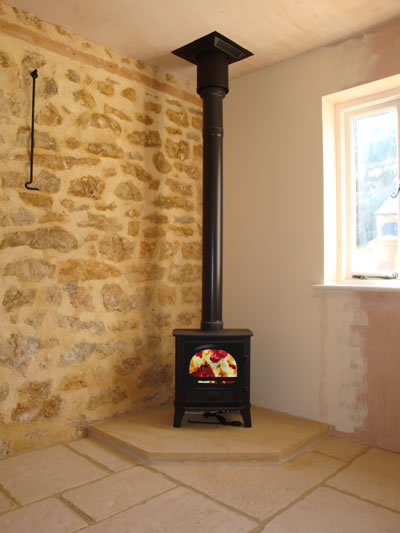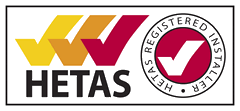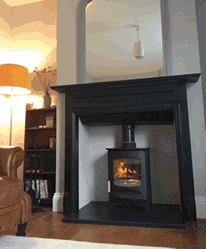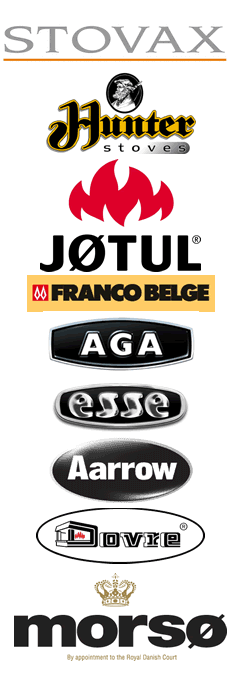StoveS - Frequently asked questions
Below are listed the most commonly asked questions about Wood Burning and Multi Fuel Stoves. If these do not answer your question, call us or send us an email
Can any property have a stove?
 Any home is suitable, or can be made suitable but you need to check if there are any planning restrictions or lease terms which restrict your options. If a house has a chimney, it is usually possible to fit a stove. If no chimney is present, a rigid flue system can be built, either straight up and through the roof, or out through the wall and up the side of the building.
Any home is suitable, or can be made suitable but you need to check if there are any planning restrictions or lease terms which restrict your options. If a house has a chimney, it is usually possible to fit a stove. If no chimney is present, a rigid flue system can be built, either straight up and through the roof, or out through the wall and up the side of the building.
How big does the stove need to be?
There are output calculators on several websites; but all these do not take into account the age or the property, the insulation level, glazed area etc. Kilowatt size is important, a too larger stove will be run 'shut down' and can cause glass blackening, tarring up of the chimney (a fire risk) and an uneconomical use of fuel.
A traditional calculation used by stove specialists over the years is a kilowatt per fourteen cubic meters of room volume. This is only a guideline, during our survey we will perform a more accurate calculation that will take into account the variables of the property.
Cast Iron or Steel
There are advantages of both types of stoves; Cast Iron heats up more slowly than steel but holds onto the heat for longer after the fire goes out; Steel has a higher tendency for warping, but cast iron can crack. Occurrences of these problems are pretty rare and are down to abuse of the stove. A good quality stove that is looked after will give you decades of reliable service.
The emphasis is on a GOOD QUALITY stove, cheaper stoves use lower quality material and are therefore more prone to problems. We at Eco-Flame can supply almost any make of stove; though if we feel that a stove is low quality we will advise you of this
Woodburning or Multi-fuel?
Wood burning stoves can only burn wood, Multi fuel stoves can burn both wood and smokeless fuel. This may sound obvious but it's a little more complicated than that.
Wood burns best with an air supply over the top of it, no ash pan or grate is required and therefore is burnt on the base of the stove. Smokeless fuel requires a supply of air from the bottom, hence a grate is required and an ash pan to catch the ash so the supply of air can be kept clear. Though you can burn wood in a multi fuel stove, due to the air supply though the grate wood burns much quicker and therefore less efficient requiring more frequent loading. Some stoves have an option wood conversion kit, this cuts down the air through the grate and so slowing the burning.
What fuel do you recommend?
Smokeless fuel can be burned in Smoke Control Areas, requires less re-fuelling, gives more heat per Kg and can reliably be expected to burn over-night. However, the task of lighting it is time-consuming and the chore of emptying the ashes daily and cleaning out the firebox before the fire can be lit tends to result in the stove being used only when it is really necessary. Additionally, smokeless fuel is dirty to handle and it is difficult to avoid getting covered in black coal-dust.
Wood, on the other hand, lights easily, burns it's own ash - doesn't need the ash pan emptying and is clean to handle. Wood needs more re-fueling and, usually, doesn't burn overnight in modern stoves. Dry wood, once up to optimum temperature, emits no smoke but is not approved for burning in Smoke Control Areas - except in the growing class of Defra Approved Woodburning Stoves. Availability for both types of fuel is excellent.
Is coal Smokeless Fuel?
The short answer is NO; multi-fuel stoves are not designed for it.:
Bituminous Coal, commonly called "Lump Coal" or "House Coal" is not suitable for multi-fuel stoves and it's use would probably invalidate the stove's warranty. It burns with long flames which pass around the throat plate and play directly on the unprotected top of the stove with the likely result of a burned out throat plate and/or cracked top plate. Bituminous coal also creates high volumes of soot which can block the throat plate and flue, causing fumes to be emitted into the room with potentially fatal results.
The only solid fuel suitable for multi-fuel stoves is smokeless fuel...or better still burn wood, cleaner, carbon neutral and sustainable. An alternative to logs are 'Green Logs'.
Why should my chimney be lined?
Your chimney sweep might tell you that your chimney is fine and doesn't need lining but your Stove Specialist will tell you that it does. Who is right? Well, the sweep may well be correct and your chimney is sound, but wrong in saying that it doesn't need lining. Stoves have special requirements which mean that no self-respecting HETAS registered installer will install into an unlined flue without a very good reason.
HETAS and all manufacturers of quality stoves recommend that the flue serving a multi-fuel or woodburning stove should be lined as part of the installation process. There are warranty and house insurance issues with not lining and HETAS could deem an un-lined installation to be "Substandard"
The traditional British chimney was designed for open fires, not stoves. Open fires are very inefficient and send huge amounts of heat up the chimney; thoroughly heating the flue right to the top, ensuring a vigorous flue-pull.
Stoves, due to their much higher efficiency, emit only a tenth of the waste heat up the chimney. This means that the upper regions of the flue are not heated sufficiently, or at all, and cause a variety of problems:
- The flue will be "lazy", not wanting to pull, resulting in a stove which is difficult to light, burns badly and blackens the glass.
- Smoke can spill back into the room when lighting and refueling.
- The moisture in the flue-gasses can condense on the flue wall and, combining with tars in the flue-gasses, create creosote which runs back down the flue into the fireplace and/or on to the stove leaving a black, stinking residue which can not be removed.
- The tar can line the chimney with a hard, glassy surface impervious to sweeping. If ignited, this can burn for days. This tar can soak right through the masonry of the chimney, often seen as a black stripe up the outside of older houses). If a chimney fire occurs, this tar expands to six times it's original volume, opening up the structure and exposing ceiling and roof timbers to the fire. Houses burn down as a result!
- Small leaks in the flue, which would be unimportant with an open fire, can be sufficient to cool the flue gasses near the top of the flue enough to cause a "cold plug" stopping further upward motion. When this happens, the stove can continue smoldering but venting the carbon monoxide laden fumes directly into the room with possibly lethal results. Many people express surprise that wood or coal gives off carbon monoxide. It is a carbon based fuel, gives off many times more carbon monoxide than the equivalent gas fire and doesn't have the sophisticated carbon monoxide detection facility of a modern gas fire.
It might seem to be an un-necessary expense on something you will never see but try imagining standing in the burned-out shell of your home or at the grave-side of a loved one and you will understand why a conscientious stove specialist will insist on lining your flue.




